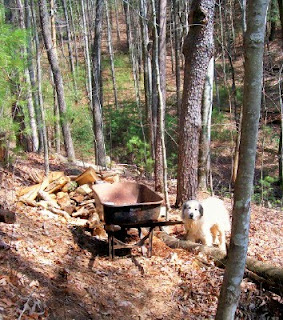Yes, I know winter hasn't ended this year for many folks and here I go writing about next years winter wood for heating. Actually I am not just going to write about this coming years wood but also the following year as wood for heating needs to be thought of well in advance of actually using it.
Because of the lay out of the land, the type of wood on the land and the actual lack of land here on the homestead, wood lot management plays a big part in the how and why of what we do for our wood needs. All of our heat in the winter is produced with wood, as is all of our cooking. Each winter we use about 5 cord of wood though each year we try to use less by closing off portions of the shack , insulating doors and windows more and this next year we are going to try and add more fire brick to the stove box to insulate it more so that it holds the heat.
We do not have a tractor here on the homestead and at this point we don't even have a working 4 wheel drive. Many places here on the land are inaccessible to both any way so we must think about where we fall trees and how we are going to get it back to the house. A mule team would be our best choice, but again, mules take feed and space, neither of which we have enough of in order to justify a team of mules at this point.
Most years we try and pick a trees in strategically located spots so that we can either roll logs or rounds down a hill, which we have plenty of, to a roadway where we then split, load on to the truck and then haul to the shack. The last couple of seasons however, large hard wood trees have come down behind the shack on a hillside that goes into a deep gully. There is no road down in there and there is no easy access but we were not going to let this wood go to waste.
Just as our luck would have i,t last year when we nearly got the ones that had fell there two years ago cleaned up, we had another large one fall in the same place. Again, we couldn't let this wood go to waste so
we the manthing has been busy cutting, splitting, chopping, throwing, throwing some more, hauling and stacking. This weekend we should know how much more, if any, wood we will need for the coming season and then begin dropping the following years wood so that it can begin to season.
Late fall, winter and very early spring are our wood working seasons. We are both allergic to bee stings so we try and stay away from the wood piles as much as possible in the warm months and wood is a much more enjoyable experience when it is cooler weather.
So here is how
our manthings wood moving and hauling has gone. It is hard to tell in the pictures the incline we are on. If you look across there is another hillside over there and the bottom of the hole is barely visible. This is where the trees fell and were cut up and split. The wood was then thrown section by section up to where it could be hauled out with the wheel barrow. This pile is about 65 foot out of the hole with a 30 foot vertical rise.
He then loads it into the wheel barrow and wheels it up the rest of the way to the shack, another 100 foot or so in distance and another 20 foot vertical rise where it is then stacked to finish seasoning for the coming winter.
Yes, this seems a lot of work and it is, but understand that we have to use and choose the wood wisely that we harvest here on the land. We are caretakers of the earth and in doing such we must be sure to not over use our natural resources nor change our ecosystem that we live in. We must respect the environment around us and in doing so Mother will provide. Part of this respect is to clean up the messes she leaves when she has a little temper tantrum.To us that in itself is providing for us, we just often don't look at it this way.

























